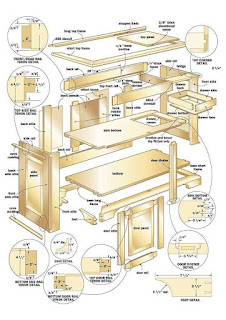Elevating the Domestic Sphere: Bespoke Woodworking Plans for Personalized Spaces
The allure of handcrafted items, imbued with personal significance and meticulous craftsmanship, continues to resonate deeply in contemporary society. While mass-produced furniture offers convenience and affordability, it often lacks the unique character and emotional connection fostered by bespoke creations. This article delves into the burgeoning world of custom woodworking plans, exploring the design process, material selection, and construction techniques that transform rudimentary blueprints into cherished, personalized pieces.
The Genesis of a Personalized Design: From Concept to Blueprint
The journey towards a bespoke woodworking project begins with a clear vision. This involves meticulous consideration of several key factors: intended function, desired aesthetic, available space, and personal preferences. A detailed concept, born from inspiration and careful planning, forms the bedrock of the entire endeavor. This process transcends the simple act of choosing a pre-existing design; it's about crafting something wholly unique, reflecting the individual's taste and lifestyle.
Defining Functionality and Purpose
Before embarking on the design phase, it's crucial to ascertain the intended function of the woodworking piece. Is it a practical storage solution, a decorative statement piece, or a combination of both? A meticulously designed bookshelf will differ significantly from a handcrafted coffee table, demanding unique structural considerations and material choices. A thorough understanding of the intended use dictates the form, dimensions, and structural integrity of the finished product.
Aesthetic Considerations: Style and Design Language
The aesthetic appeal of a woodworking project is deeply intertwined with personal expression. Consider the overarching style desired: rustic charm, sleek minimalism, classical elegance, or a fusion of styles. Exploring various design elements—from the choice of wood species to the detailing of joints—allows for the articulation of a distinct aesthetic. Reference images, mood boards, and stylistic precedents can aid in refining the design concept, ensuring visual coherence and consistency.
Space and Scale: Harmonizing with the Existing Environment
The physical dimensions of the intended space must be carefully considered to avoid creating a piece that overwhelms or clashes with its surroundings. Detailed measurements of the area designated for the woodworking project are paramount. Understanding the scale of the piece relative to existing furniture and architectural features is essential for achieving a harmonious integration within the existing environment. Accurate scale drawings are crucial to prevent costly errors during construction.
Material Selection: The Heart of the Design
The choice of wood species plays a pivotal role in determining the final appearance, durability, and longevity of the project. Each type of wood possesses unique properties, influencing its workability, grain pattern, color, and overall aesthetic appeal. Hardwoods, such as oak, maple, and cherry, offer superior durability and strength, while softwoods, like pine and cedar, are easier to work with but may be less resilient. Careful consideration of the wood's characteristics—its density, grain, and susceptibility to warping—is vital for successful project execution.
From Blueprint to Reality: Mastering the Construction Process
With the design finalized and materials procured, the construction phase commences. This stage requires precision, patience, and a deep understanding of woodworking techniques. The complexity of the project dictates the tools and equipment needed, ranging from basic hand tools to advanced power machinery.
Essential Woodworking Tools and Equipment
A comprehensive toolkit is crucial for successful woodworking. Essential tools include: measuring tapes, squares, chisels, hand saws, planes, drills, sanders, and clamps. Depending on the complexity of the project, more specialized tools, such as routers, jointers, and planers, might be required. The proper use and maintenance of these tools are paramount for safety and efficiency.
Precision Cutting and Joint Making
Accurate cutting is foundational to successful woodworking. Precise measurements and the use of appropriate cutting tools are essential for creating components that fit together seamlessly. Different types of joints—mortise and tenon, dovetail, butt, lap—offer varying degrees of strength and aesthetic appeal, and the selection of the most appropriate joint type is critical to the structural integrity of the finished piece.
Assembly and Finishing Touches
Once all components are cut and shaped, the assembly process begins. Careful alignment and the secure fastening of components are crucial for ensuring the structural stability and overall integrity of the finished product. This stage often involves the use of adhesives, screws, dowels, or a combination thereof. Finally, sanding and finishing techniques are employed to enhance the appearance and protect the wood from damage.
Finishing Techniques: Enhancing the Aesthetic Appeal
The final stage involves the application of a finish, enhancing both the aesthetic appeal and the longevity of the piece. A range of finishing options are available, including stains, varnishes, lacquers, and oils, each imparting a unique look and level of protection. The choice of finish depends on personal preference and the desired level of durability and sheen.
Beyond the Blueprint: The Enduring Legacy of Custom Woodworking
The creation of a bespoke woodworking project extends far beyond the mere construction of a functional object. It's a deeply personal and rewarding experience that fosters creativity, problem-solving skills, and a profound appreciation for handcrafted artistry. The resulting piece serves not only as a functional addition to the domestic sphere but also as a tangible representation of the maker's skill, dedication, and personal vision. The enduring legacy of custom woodworking lies in its ability to transform ordinary spaces into unique, personalized environments, rich with character and imbued with a profound sense of individual expression.
In conclusion, the process of designing and crafting custom woodworking projects offers a unique opportunity for personal expression and the creation of enduring, cherished pieces. By carefully considering the design elements, selecting appropriate materials, and mastering construction techniques, individuals can transform their homes into spaces that reflect their individual tastes and create a legacy of handcrafted beauty.


0 comments:
Post a Comment